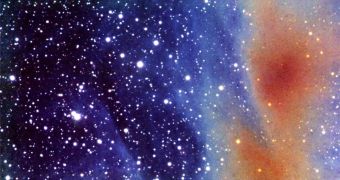In anticipation of the launch of the Visible and Infrared Survey Telescope for Astronomy, or VISTA, expected to become operational by the middle of the current year, astronomers from the European Organization for Astronomical Research have mapped the content of a dark filament of molecular cloud named Corona Australis, located in the Southern Crown constellation about 500 light years away from Earth, with the greatest detail yet.
The 45 light years long cloud of gas emits light in the near-infrared wavelengths of the electromagnetic spectrum, the so-called cloudshine effect. ESO's New Technology Telescope was able to reveal that the large distances between the stars in the Corona Australis gas filament are filled with complex structures of cold gas, opaque to invisible light, and that these giant gas accumulations have a great opportunity to generate a future star formation process.
Such star cradles are extremely important to astronomers, since they can provide valuable information regarding their formation and evolution. However, they are opaque to light, thus the matter distribution within them cannot be observed through optical techniques, and require indirect methods such as measuring the light provided by the stars and filtered through the whole mass of cloud. An extremely useful technique, since usually the matter distribution is in direct relation to the distribution of stars, says Polo Padoan, co-author of the study.
Two years ago, Padoan was involved in another study related to measuring the matter distribution in a cloud of molecular gas, by measuring the amount of scattered light coming from background stars. The light emitted by stars is being scattered and absorbed in the clouds, making them appear redder than they actually are, an effect known to astronomers as 'reflection nebulae'. Visible light is shifted towards the red end of the optical spectrum, until it becomes near-infrared radiation that can easily penetrate the mass of the cloud and escape into interstellar space for us to observe.
Depending on the brightness or the light emission, astronomers can then approximate the density of material in the respective nebula. Mika Juvela, the lead author of the study, writes that the first test regarding this method has been conducted in the summer of 2006 by using ESO's New Technology Telescope, located in La Silla, Chile and involved a 21-hour long observation of the Corona Australis molecular cloud. The final results of the test have clearly revealed that the scattering method is able to provide with a detailed map of the matter distribution, and is as reliable as observations of background stars, only that with higher detail.
High-resolution images of dark clouds can now provide with detailed internal structures and dynamics, while eliminating the variable related to the distribution of background stars within the cloud itself, as sometimes the cloud density is simply too high for optical light to penetrate all the way through the entire mass of gas.
Due to the study led by Juvela, now astronomers finally have an important tool in the study of interstellar masses of gas and star formation processes in the galaxies.

 14 DAY TRIAL //
14 DAY TRIAL //